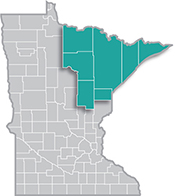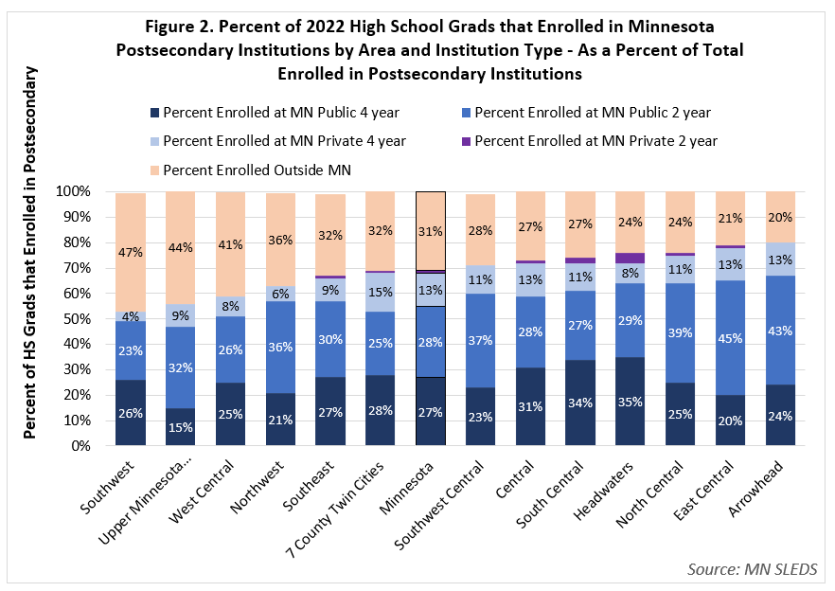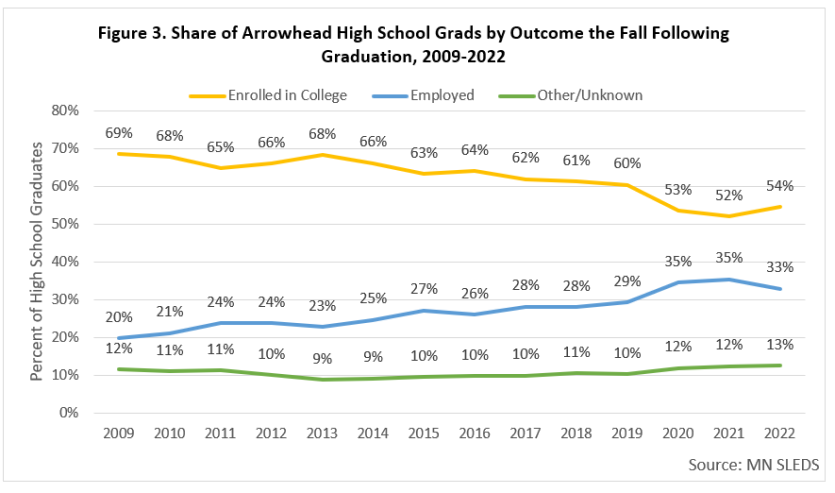 Home to the state's second-largest metro, the Northeast Region has a strong industrial sector, tied largely to the area's abundant natural resources.
Home to the state's second-largest metro, the Northeast Region has a strong industrial sector, tied largely to the area's abundant natural resources.
Most of the manufacturing base centers on mining and forest products industries. More than half of the sector's employment is in paper and machinery manufacturing.
Want the freshest data delivered by email? Subscribe to our regional newsletters.
The Statewide Longitudinal Education Data System (SLEDS) is a rich source of information for anyone interested in Minnesota's education system, from pre-kindergarten to postsecondary and beyond. As the result of collaboration across several state agencies, the data in SLEDS provides valuable insights into the relationship between students and the workforce, and how that dynamic changes over time. I'll share a few highlights from Northeast Minnesota to introduce you and, hopefully, pique your interest.
 A common topic of conversation throughout the workforce development, economic development and education worlds is the movement and behavior of young people as they graduate from high school. This is a question that SLEDS can provide some insight into. SLEDS is able to track high school graduates and whether they opt to enroll in postsecondary education or enter the workforce directly.
A common topic of conversation throughout the workforce development, economic development and education worlds is the movement and behavior of young people as they graduate from high school. This is a question that SLEDS can provide some insight into. SLEDS is able to track high school graduates and whether they opt to enroll in postsecondary education or enter the workforce directly.
Of the nearly 3,100 students that graduated from public high schools in the 7-county Northeast Minnesota region, also called the Arrowhead Region, in 2022, 1,685 (54%) opted to enroll in some type of postsecondary program the following fall (see Figure 1).
Of the 1,685 students that enrolled in postsecondary programs, 80% did so at a Minnesota institution. In comparison to the state as a whole, the Arrowhead had a smaller than average share of graduates choosing college, but those that did were much more likely to end up at a Minnesota school than graduates from other economic development regions (see Figure 2). The Arrowhead also had a higher-than-average share of enrollees at 2-Year state colleges compared to other regions. This likely is connected to the strong history and connections of programs at Minnesota North College, Lake Superior College and Fond du Lac Tribal & Community College. More than two out of every five high school grads in Northeast Minnesota that continued their education chose to do so at a state community or technical college.

However, as mentioned above, not all high school graduates choose to pursue formal postsecondary education. Indeed, a sizeable—and growing—share have chosen to enter the workforce immediately after high school. In 2022, the share in the Arrowhead was around 33% of graduates, or more than 1,000 individuals, up from 20% in 2009. While many of the graduates that enrolled in postsecondary likely also have jobs, the "employed" number represents those that are employed only and not studying as well. An additional 13% had unknown outcomes, likely meaning they were employed outside of Minnesota or were not working or enrolled in college.
As the number and share of graduates in the Arrowhead that go to college have fallen, the share that entered the workforce has grown. The share of grads that immediately started working peaked in 2021, responding to the impacts of the pandemic. Many young people took advantage of employment opportunities and rapidly rising wages that did not exist even a year or two before. Data from 2022 indicates a readjustment back toward pre-pandemic trends, both for enrollment and employment shares, at least for Northeast Minnesota grads. The share with Other or Unknown outcomes has also grown since 2019 (see Figure 3).

If you find these datasets useful, you are in luck. SLEDS data covers many other aspects of education and the workforce at greater local detail, down to school district and even individual schools. You can also peruse academic outcomes, such as test scores and college completion rates. On the workforce side, you can see how employed graduates are distributed by industry and what their typical wages are.
While all of this is useful to current high school students to follow trends in their area, I have found that the data showing where previous graduates of their school or district have enrolled is of particular interest to recent grads. This too, is available via SLEDS, along with so much more. I encourage you to dive in and explore, and feel free to reach out with any questions you have; I am more than happy to discuss the amazing resource that is SLEDS!
For more information, contact Carson Gorecki at carson.gorecki@state.mn.us.
11/25/2024 10:51:01 AM
Carson Gorecki
The Statewide Longitudinal Education Data System (SLEDS) is a rich source of information for anyone interested in Minnesota's education system, from pre-kindergarten to postsecondary and beyond. As the result of collaboration across several state agencies, the data in SLEDS provides valuable insights into the relationship between students and the workforce, and how that dynamic changes over time. I'll share a few highlights from Northeast Minnesota to introduce you and, hopefully, pique your interest.
 A common topic of conversation throughout the workforce development, economic development and education worlds is the movement and behavior of young people as they graduate from high school. This is a question that SLEDS can provide some insight into. SLEDS is able to track high school graduates and whether they opt to enroll in postsecondary education or enter the workforce directly.
A common topic of conversation throughout the workforce development, economic development and education worlds is the movement and behavior of young people as they graduate from high school. This is a question that SLEDS can provide some insight into. SLEDS is able to track high school graduates and whether they opt to enroll in postsecondary education or enter the workforce directly.
Of the nearly 3,100 students that graduated from public high schools in the 7-county Northeast Minnesota region, also called the Arrowhead Region, in 2022, 1,685 (54%) opted to enroll in some type of postsecondary program the following fall (see Figure 1).
Of the 1,685 students that enrolled in postsecondary programs, 80% did so at a Minnesota institution. In comparison to the state as a whole, the Arrowhead had a smaller than average share of graduates choosing college, but those that did were much more likely to end up at a Minnesota school than graduates from other economic development regions (see Figure 2). The Arrowhead also had a higher-than-average share of enrollees at 2-Year state colleges compared to other regions. This likely is connected to the strong history and connections of programs at Minnesota North College, Lake Superior College and Fond du Lac Tribal & Community College. More than two out of every five high school grads in Northeast Minnesota that continued their education chose to do so at a state community or technical college.

However, as mentioned above, not all high school graduates choose to pursue formal postsecondary education. Indeed, a sizeable—and growing—share have chosen to enter the workforce immediately after high school. In 2022, the share in the Arrowhead was around 33% of graduates, or more than 1,000 individuals, up from 20% in 2009. While many of the graduates that enrolled in postsecondary likely also have jobs, the "employed" number represents those that are employed only and not studying as well. An additional 13% had unknown outcomes, likely meaning they were employed outside of Minnesota or were not working or enrolled in college.
As the number and share of graduates in the Arrowhead that go to college have fallen, the share that entered the workforce has grown. The share of grads that immediately started working peaked in 2021, responding to the impacts of the pandemic. Many young people took advantage of employment opportunities and rapidly rising wages that did not exist even a year or two before. Data from 2022 indicates a readjustment back toward pre-pandemic trends, both for enrollment and employment shares, at least for Northeast Minnesota grads. The share with Other or Unknown outcomes has also grown since 2019 (see Figure 3).

If you find these datasets useful, you are in luck. SLEDS data covers many other aspects of education and the workforce at greater local detail, down to school district and even individual schools. You can also peruse academic outcomes, such as test scores and college completion rates. On the workforce side, you can see how employed graduates are distributed by industry and what their typical wages are.
While all of this is useful to current high school students to follow trends in their area, I have found that the data showing where previous graduates of their school or district have enrolled is of particular interest to recent grads. This too, is available via SLEDS, along with so much more. I encourage you to dive in and explore, and feel free to reach out with any questions you have; I am more than happy to discuss the amazing resource that is SLEDS!
For more information, contact Carson Gorecki at carson.gorecki@state.mn.us.